Edge computing in cochlear implant processors is driving rapid advancements in device miniaturization, smart sound processing, and seamless connectivity. Expect more personalized hearing experiences with AI-powered noise suppression, environmental adaptation, and real-time adjustments. Battery life improves through power-efficient designs, while secure data handling guarantees privacy. Integration with smart home tech and wearables further enhances user control. To discover how these innovations shape the future of hearing, keep exploring what’s next.
Key Takeaways
- Edge computing enables real-time sound analysis and environmental adaptation directly on cochlear implant processors, reducing latency.
- Future designs will integrate AI-powered edge algorithms for personalized auditory experiences and noise filtering.
- Power-efficient edge processing will extend battery life while supporting complex functions without external devices.
- Enhanced security measures will protect sensitive audio data processed locally, addressing privacy concerns.
- Standardization and interoperability will facilitate seamless integration of edge computing features across diverse cochlear implant models.
Advances in Miniaturization and Device Integration
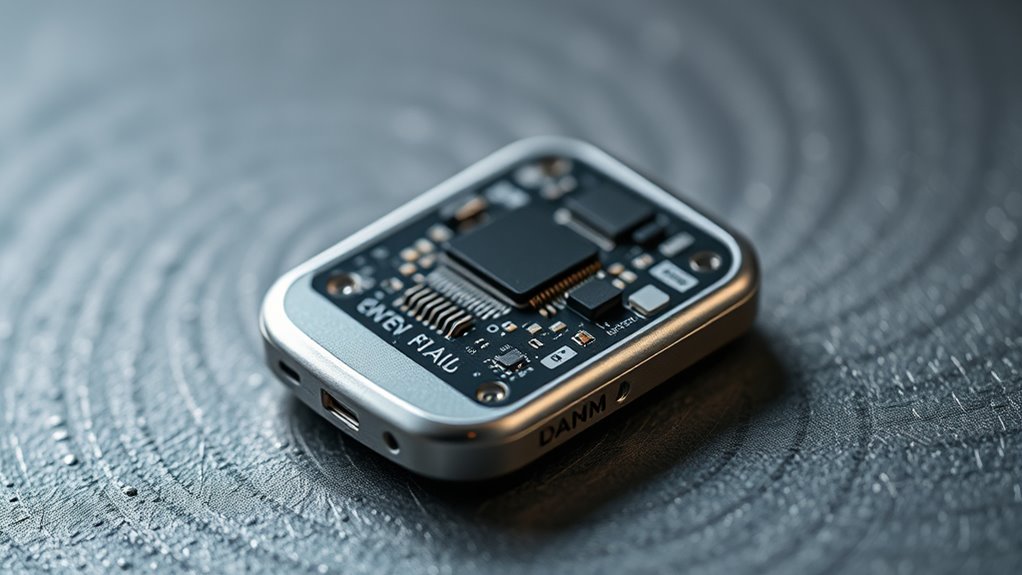
Recent advances in miniaturization and device integration have substantially transformed cochlear implant processors. As you explore these innovations, you’ll notice that improved biocompatibility design guarantees the devices are safe and comfortable for long-term use inside your body. Smaller components allow for more discreet implants, enhancing user confidence. Additionally, these developments facilitate manufacturing scalability, making it easier to produce high-quality devices at larger volumes without sacrificing performance. The integration of multiple functions into compact units reduces overall size, enabling more natural movement and less discomfort. These technological strides not only improve the user experience but also pave the way for more accessible and affordable solutions, ensuring that more people can benefit from advanced cochlear implant technology. Moreover, incorporating ethical hacking principles into device development can help identify and mitigate security vulnerabilities, ensuring patient data and device functionality remain protected.
Enhancing Sound Processing With Artificial Intelligence
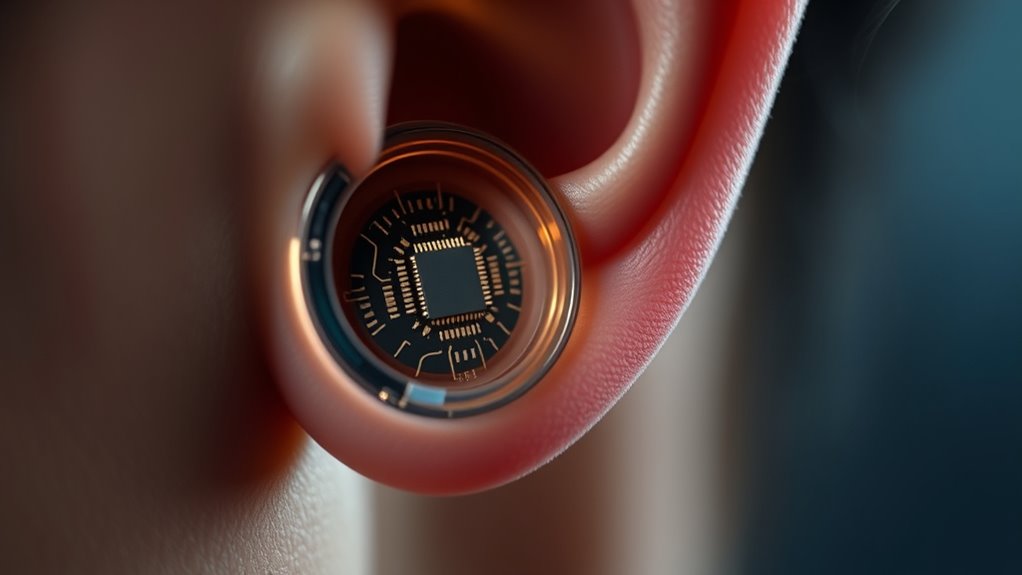
Artificial intelligence is transforming how cochlear implant processors interpret and enhance sound signals, providing you with a more natural listening experience. AI optimization allows the device to analyze complex sound environments quickly, improving overall sound clarity. With advanced algorithms, AI-driven sound enhancement filters out distortions and emphasizes speech, making conversations easier to follow. These improvements help you distinguish between different sounds and understand speech more accurately, even in noisy settings. As AI continues to evolve, it enables your cochlear implant to adapt dynamically to changing environments, providing seamless audio experiences. Additionally, sound environment analysis plays a crucial role in tailoring the device’s performance to your specific surroundings, further enhancing auditory perception. By integrating AI-driven sound processing, your device becomes smarter, delivering sharper, clearer sound and reducing listening fatigue, ultimately enhancing your quality of life through better auditory perception.
Real-Time Noise Suppression and Environmental Adaptation

Real-time noise suppression and environmental adaptation enable your cochlear implant to automatically filter out background sounds and focus on relevant audio cues. Using adaptive filtering, your device analyzes the acoustic scene to distinguish speech from noise, adjusting in real-time for best clarity. Acoustic scene analysis allows it to identify whether you’re in a crowded restaurant, outdoor park, or quiet room, tailoring its filtering strategies accordingly. This dynamic process helps you hear conversations more clearly without manual adjustments. By leveraging edge computing, your implant processes complex algorithms locally, ensuring minimal latency. As a result, you experience smoother soundscapes and better environmental awareness, making it easier to engage confidently in various settings. This continuous adaptation enhances your overall hearing experience, providing more natural and effortless listening. Additionally, ongoing research into AI vulnerabilities underscores the importance of robust safety measures to ensure reliable performance of AI-powered devices.
Improving Battery Life and Power Efficiency
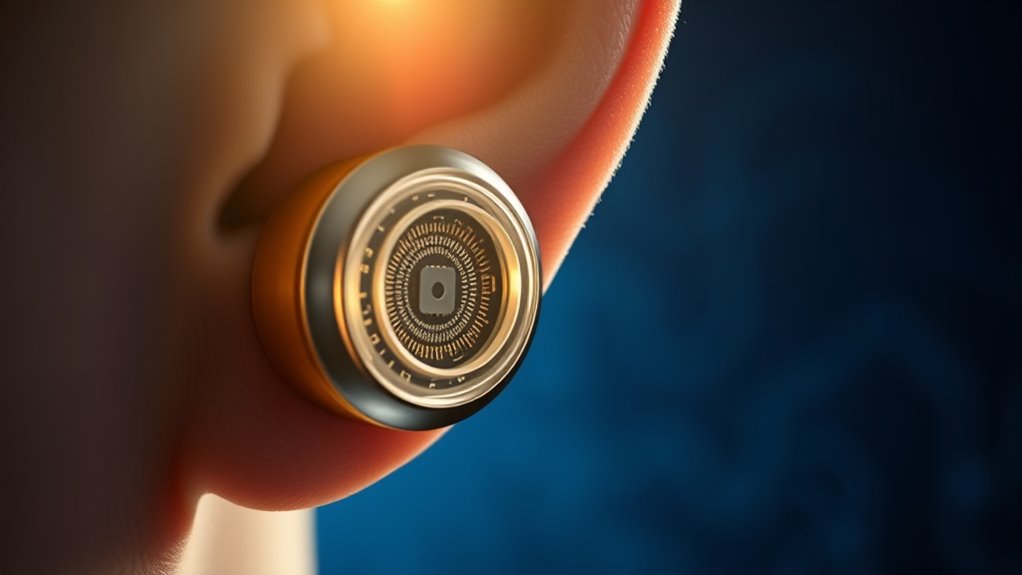
As your cochlear implant continuously adapts to your environment through edge computing, managing power consumption becomes increasingly important. You can enhance battery life through targeted battery optimization techniques that reduce unnecessary energy usage. Efficient power management strategies, such as dynamic voltage scaling and intelligent sleep modes, help conserve energy during periods of low activity. Hardware improvements, like low-power processors and energy-efficient sensors, also play a critical role. Implementing these measures ensures your device remains functional longer between charges, maintaining consistent performance. Additionally, hardware efficiency improvements can significantly reduce overall power consumption, leading to longer battery life. By focusing on power management and battery optimization, manufacturers can create smarter cochlear implants that support extended use without sacrificing responsiveness or accuracy. This balance is essential for improving your daily experience and device reliability.
Wireless Connectivity and Data Streaming Capabilities

Wireless connectivity and data streaming capabilities are transforming how cochlear implant processors communicate with external devices, allowing seamless transfer of sound data and user settings. With wireless streaming, you can effortlessly connect your implant to smartphones, tablets, or other audio sources, enabling real-time audio transmission without cumbersome cables. Data synchronization ensures your device stays updated with the latest settings and firmware, reducing manual adjustments and improving user experience. These features also enhance convenience during everyday activities, letting you receive calls, listen to music, or control volume directly through your implant. As wireless technology advances, expect faster, more reliable connections that support high-quality audio streaming, making your cochlear implant more integrated into your digital life. This progress paves the way for smarter, more responsive hearing solutions. Incorporating advanced wireless technologies improves overall performance and user satisfaction, setting new standards in cochlear implant functionality.
Personalized Hearing Profiles and User Customization
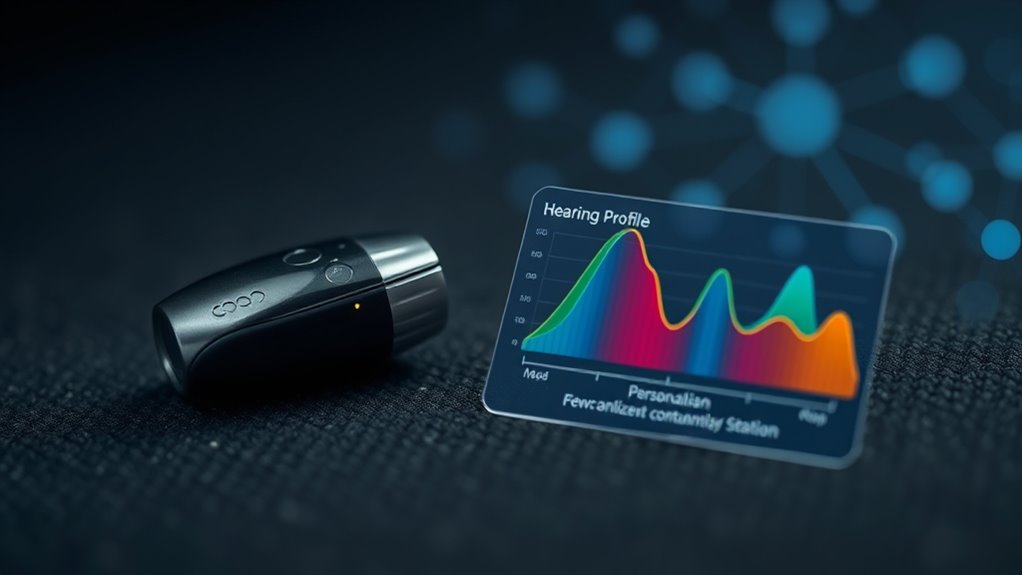
Advancements in wireless connectivity have made it easier to tailor cochlear implant settings to your individual hearing needs. With improved data transfer, you now have access to a variety of customization options that enhance your listening experience. Hearing profile personalization allows you to adjust settings based on your environment, preferences, and specific hearing loss characteristics. You can fine-tune sound quality, speech clarity, and background noise reduction directly from your device or smartphone app. This level of user customization guarantees your implant adapts seamlessly to different situations, providing a more natural and comfortable experience. As technology evolves, personalized hearing profiles will become even more intuitive, giving you greater control over how you hear and interact with the world around you. Incorporating real-time adjustments into your settings further optimizes your hearing experience on the go.
Secure Data Handling and Privacy Considerations

You need to guarantee your data stays protected as edge computing handles sensitive information. Improving encryption standards and adding user data anonymity measures are vital steps. You’ll also face regulatory compliance challenges that require careful navigation to keep user trust intact. Incorporating Pimple Patch technologies as a metaphor can help illustrate the importance of layered security measures in safeguarding data.
Encryption Standards Enhancement
To guarantee the privacy and security of sensitive user data in edge computing for cochlear implant processors, enhancing encryption standards is essential. You should adopt stronger cryptographic protocols that resist emerging threats and ensure data remains protected during transmission and storage. Upgrading encryption algorithms, like moving to AES-256, helps prevent unauthorized access. Additionally, integrating data anonymization techniques can reduce risks if data is compromised, by removing identifiable information. Implementing secure key management practices is also crucial to maintain cryptographic integrity and prevent key compromise. By focusing on robust encryption standards, you maintain user trust and comply with privacy regulations. Continuous evaluation and implementation of advanced cryptographic solutions safeguard sensitive health data, ensuring it remains confidential throughout its lifecycle. This proactive approach prepares your system for future security challenges while prioritizing user privacy.
User Data Anonymity Measures
Building on robust encryption standards, implementing user data anonymization techniques further enhances privacy in edge computing for cochlear implant processors. By removing identifiable information from data before processing, you protect user privacy and prevent potential breaches. Data anonymization ensures that even if data is intercepted or accessed without authorization, it remains unusable for identifying individuals. This approach minimizes risks associated with sensitive health information, fostering user trust. You should also adopt consistent anonymization protocols and regularly review them to adapt to evolving threats. Combining these measures with strong encryption creates a layered defense, making it considerably harder for malicious actors to compromise user data. Ultimately, prioritizing user privacy through effective data anonymization safeguards user confidence and supports secure, responsible use of edge computing technologies.
Regulatory Compliance Challenges
Steering the regulatory landscape for edge computing in cochlear implant processors presents significant challenges, particularly around secure data handling and privacy considerations. You must navigate complex requirements like obtaining ethical approval and adhering to international standards to protect user data. Guaranteeing compliance involves balancing innovation with legal obligations, which can slow development. To illustrate, consider this table:
| Aspect | Consideration |
|---|---|
| Ethical approval | Validates data use and privacy safeguards |
| International standards | Ensures compatibility and legal compliance |
| Data security | Protects against breaches and misuse |
| Privacy regulations | Maintains user trust and legal adherence |
Adhering to these elements is vital to deploying safe, compliant edge solutions. Failing to meet regulations could lead to delays, fines, or loss of user trust. Moreover, understanding data governance principles is essential for effectively managing user information within regulatory frameworks.
Integration With Smart Home and Wearable Technologies
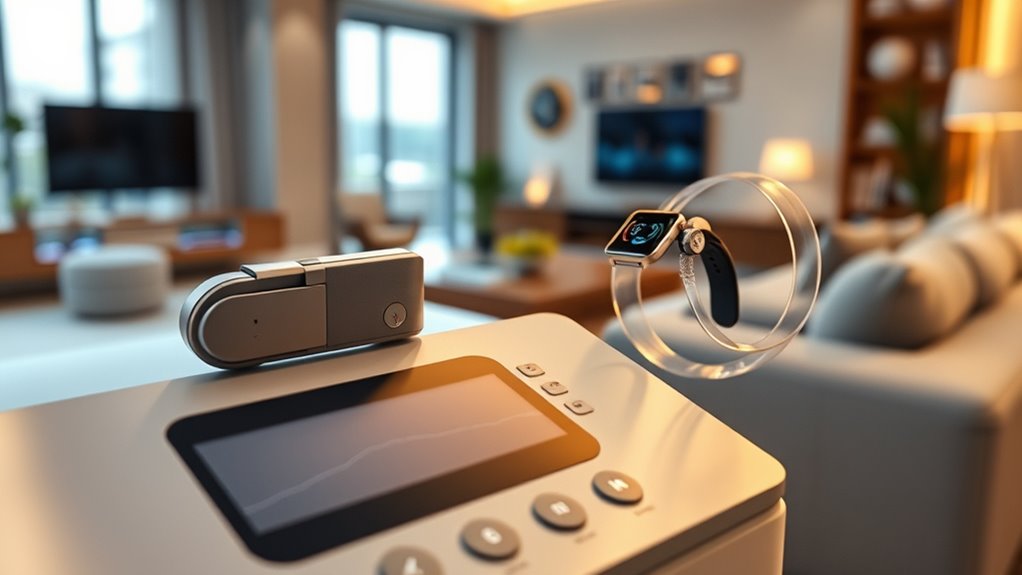
Integrating cochlear implant processors with smart home and wearable technologies opens up new possibilities for seamless communication and enhanced quality of life. With voice-controlled interfaces, you can effortlessly manage your devices, adjusting volume or changing settings without needing to touch your processor. Home automation systems become more accessible, allowing your cochlear implant to connect directly with lights, thermostats, or security systems, creating a more integrated environment. This integration enables real-time adjustments based on your surroundings or preferences, providing a more natural listening experience. By linking your implant to wearable tech, such as fitness trackers or smartwatches, you gain greater control and personalized settings. Additionally, space and organization can play a role in optimizing your environment for better device performance and easier access to controls. Overall, this connectivity simplifies daily routines, promotes independence, and enhances your interaction with your environment.
Challenges and Regulatory Considerations

While connecting cochlear implant processors to smart home and wearable devices offers many benefits, it also introduces significant challenges and regulatory hurdles. Ensuring data privacy and security is critical, especially with sensitive health information. Ethical concerns arise around user consent and data misuse. Regulatory agencies emphasize strict manufacturing standards to guarantee device safety and reliability. Meeting these standards requires rigorous testing and compliance checks, which can delay deployment. Additionally, interoperability issues may hinder seamless integration. Consider the table below, highlighting key aspects:
| Challenge | Regulatory Focus | Impact |
|---|---|---|
| Data privacy/security | Data protection laws, ethical use | User trust, legal compliance |
| Manufacturing standards | Safety certifications, quality control | Device reliability, safety |
| Interoperability issues | Standardization, compatibility | User experience, functionality |
These factors demand ongoing attention to ensure safe, ethical, and compliant edge computing solutions.
Future Trends and Emerging Innovations

As technology advances, edge computing in cochlear implant processors is poised to undergo transformative innovations that enhance user experience and clinical outcomes. Biomimetic design will play a pivotal role, allowing devices to mimic natural ear functions more closely, leading to more accurate sound perception. Neural interface advancements will enable more seamless communication between the implant and the nervous system, reducing latency and improving sound clarity. Future trends also include smarter algorithms that adapt in real-time to environmental changes, offering personalized hearing solutions. Additionally, miniaturization and energy efficiency will make implants more discreet and longer-lasting. These innovations will empower users with better sound quality, intuitive control, and improved overall quality of life, shaping the next generation of cochlear implant technology.
Frequently Asked Questions
How Does Edge Computing Improve Cochlear Implant Sound Quality?
You might wonder how sound quality improves in cochlear implants. Edge computing plays a key role by enabling real-time sound enhancement directly on the device, which reduces latency and provides faster responses. This immediate processing improves clarity, background noise filtering, and overall sound quality. By minimizing delays, you experience a more natural hearing sensation, making conversations and environmental sounds clearer and more comfortable, especially in challenging listening environments.
What Are the Main Security Concerns With Wireless Data Streaming?
When you’re streaming data wirelessly, security concerns include wireless vulnerabilities that could expose your personal information. Hackers might intercept signals or access unprotected networks, risking data breaches. To protect yourself, verify your device uses strong data encryption, which secures your information during transmission. Always keep your software updated and connect only to trusted networks to minimize risks and safeguard your sensitive health data effectively.
Can Edge Devices Adapt to Sudden Environmental Changes Automatically?
Imagine your device as a vigilant lighthouse keeper, constantly adjusting to changing weather. With adaptive algorithms and environmental sensors, edge devices can automatically respond to sudden environmental changes. You don’t need to manually recalibrate; instead, the device detects shifts—like noise or temperature fluctuations—and adapts instantly. This seamless responsiveness ensures peak performance, making your experience smoother and more reliable, no matter what the environment throws your way.
How Will AI Personalize Hearing Experiences for Individual Users?
You’ll see AI personalize your hearing experience through advanced personalization algorithms that analyze your environment and preferences in real-time. By continuously gathering user feedback, the system adapts to your unique needs, optimizing sound clarity and comfort. This dynamic process guarantees your cochlear implant responds intelligently, providing a seamless listening experience tailored specifically to you, making it feel more natural and effortless every time you use it.
What Regulatory Hurdles Exist for Integrating Smart Home Features?
Oh, steering the endless maze of smart home features, huh? You’ll need regulatory approval and strict privacy compliance to get them off the ground. Governments demand safety checks, data protections, and clear user rights, making innovation feel like a bureaucratic dance. You’ll face hurdles ensuring your devices meet standards, protecting user privacy, and avoiding privacy breaches. It’s a tedious process, but necessary to keep everyone’s digital home safe and compliant.
Conclusion
As you cling to the dream of a tiny, AI-powered cochlear implant that’s smarter than your smartphone, remember: with great power comes great responsibility—and even greater battery life. So enjoy the convenience of wireless streaming and environmental adaptation, but don’t forget the lurking challenges of privacy and regulation. After all, who wouldn’t want their hearing aids to double as surveillance devices? The future’s bright… just maybe not for your battery.











